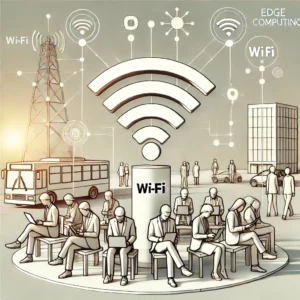
AI-Driven Edge Computing: Transforming Public Wi-Fi into Smart Hubs
Table of Contents
- What is Edge Computing?
- Public Wi-Fi as Smart Hubs: The Role of AI and Edge Computing
- Bridging the Digital Divide: How AI and Edge Infrastructure Can Lower Digital Access Costs in Africa
- ARED’s Role in the Future of Edge Computing
- Conclusion
What is Edge Computing?
Edge computing is a distributed computing model that brings data processing closer to where data is generated. This results in faster processing, reduced latency, and enhanced security, which are critical for applications like public Wi-Fi.
Instead of sending all data to the cloud for processing, edge computing leverages edge gateways, like the ones developed by ARED, to handle processing closer to the user. This shift is crucial in environments that demand real-time data handling, such as public Wi-Fi networks in bustling urban areas.
By incorporating AI into edge computing, we can enhance these networks’ capacity to handle complex tasks such as managing user traffic, delivering targeted content, and analyzing feedback on the spot. This transformation is particularly valuable in smart cities and regions like Africa, where improving connectivity can help bridge the digital divide.
Public Wi-Fi as Smart Hubs: The Role of AI and Edge Computing
Public Wi-Fi networks are evolving into smart hubs with the integration of AI-driven edge computing. Here’s how AI at the edge enhances public Wi-Fi services:
Intelligent Data Traffic Management
Managing data traffic is one of the core functions of public Wi-Fi networks. Traditional systems often face congestion, especially in crowded areas like bus terminals or shopping malls.
By implementing AI agents on edge gateways, public Wi-Fi networks can:
- Prioritize bandwidth for critical applications.
- Balance data traffic dynamically in real-time.
This ensures a smooth user experience, even during peak usage times. The ARED edge gateways enable this by processing data locally, reducing delays, and optimizing network performance.
Real-Time Advertisements and Services
Edge computing also facilitates the delivery of real-time advertisements and personalized services. AI agents can analyze user data at the edge and generate relevant ads or service offers without sending sensitive data to the cloud, ensuring greater privacy and immediate delivery.
For example, in shopping malls, public Wi-Fi networks powered by ARED’s edge infrastructure can offer personalized promotions to users based on their location or past behavior, improving user engagement and increasing sales for local businesses.
User Feedback and Service Optimization
AI at the edge can also collect and analyze user feedback in real-time, enabling immediate improvements to the network or services. This is particularly useful for public Wi-Fi providers who want to continuously enhance the user experience.
ARED’s edge gateways allow for the collection and processing of this feedback without relying on slow, centralized cloud systems, ensuring that improvements can be made swiftly and effectively.
Bridging the Digital Divide: How AI and Edge Infrastructure Can Lower Digital Access Costs in Africa
One of the biggest challenges in Africa is the digital divide—the gap between those with access to modern digital services and those without. AI-driven edge computing offers a solution to this problem by reducing the costs of digital access.
Lowering Connectivity Costs with Edge Computing
Traditional centralized internet services can be expensive due to high infrastructure and operational costs. However, edge computing can lower these costs by reducing the reliance on expensive, far-off cloud data centers.
By processing data closer to the user with edge gateways like those developed by ARED, service providers can reduce their operational costs and pass these savings on to consumers, making internet access more affordable and accessible.
For more insights into how AI agents at the edge can enhance privacy and security, check out our detailed article.
Boosting Local Economies
As public Wi-Fi networks become smarter and more affordable through edge computing, they can support local economies in several ways. Entrepreneurs can:
- Use public Wi-Fi to promote their businesses with targeted ads.
- Leverage edge-powered networks to create and distribute local content.
This digital infrastructure supports economic growth by empowering local businesses to reach larger audiences with minimal investment in costly digital platforms.
Improving Education and Healthcare Access
In addition to supporting local businesses, edge computing can also play a critical role in improving education and healthcare. By providing public Wi-Fi in rural areas or underserved urban communities, students and patients can access:
- Offline educational materials when internet connectivity is limited.
- Telehealth services through low-cost Wi-Fi infrastructure.
ARED’s edge computing technology ensures that even in areas with limited internet access, critical services remain available.

ARED’s Role in the Future of Edge Computing
At ARED, we are transforming public Wi-Fi networks across Africa by integrating AI-driven edge computing into our edge gateways. Our mission is to bring fast, secure, and cost-effective internet access to underserved communities.
By decentralizing data processing and leveraging AI at the edge, we can offer smarter services, reduce latency, and improve security. This not only improves the user experience but also helps bridge the digital divide by making digital services more affordable.
For more on how ARED is shaping the future of connectivity in Africa, visit our official website or explore how we’re working to bridge the digital divide.
Conclusion
AI-driven edge computing is revolutionizing public Wi-Fi networks, turning them into intelligent hubs capable of handling data traffic, advertisements, and feedback in real-time. This technology, powered by ARED’s edge gateways, not only enhances public Wi-Fi services but also helps lower digital access costs, making it a crucial tool in bridging the digital divide in Africa.
As smart cities continue to develop, the integration of AI and edge infrastructure will play a key role in creating more connected, efficient, and inclusive digital ecosystems. With ARED at the forefront of this transformation, the future of connectivity looks brighter than ever.


